Recent Fire Damage Posts
Planning and Preparing for Fire Disasters | SERVPRO of Cedar City/Fillmore
5/6/2024 (Permalink)
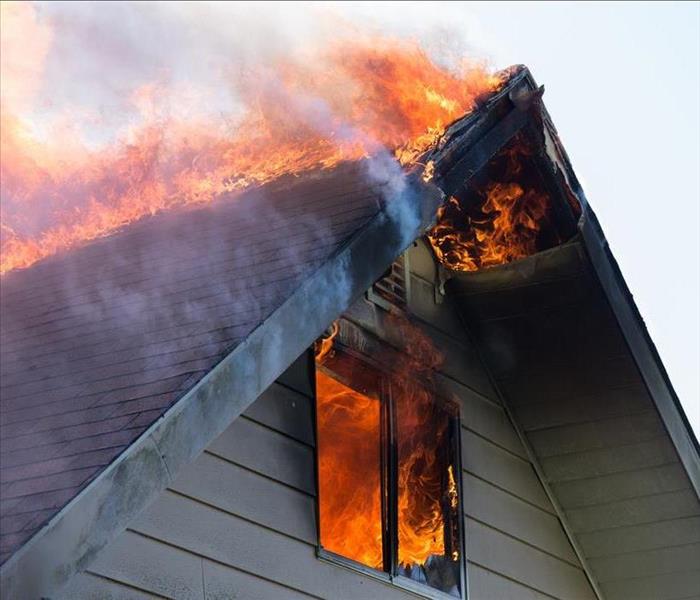 Ensure the safety of your household and loved ones. Reach out to SERVPRO of Cedar City/Fillmore today.
Ensure the safety of your household and loved ones. Reach out to SERVPRO of Cedar City/Fillmore today.
House fires can happen at any time and to anyone, and they can cause serious destruction to your beloved family home. That’s why it’s important to prepare your family for a potential house fire disaster before a true emergency occurs.
By taking the necessary precautions and practicing fire safety, you can help keep your family safe. Our SERVPRO® team offers some tips to help you prepare for a house fire below.
Create an Emergency Plan
Creating an emergency plan is the first step in preparing for a house fire. Make sure that everyone in your household is familiar with the emergency plan and knows what to do in case of a fire. The emergency plan should include a designated meeting place outside of the home, emergency phone numbers and escape routes from each room in the house.
It’s important to practice the emergency plan with your family so that everyone knows what to do in case of a fire. Have your family pick different places around your home to be in and then simulate a fire emergency. Time everyone to see how long it takes for your family to get to safety!
Install Smoke Detectors
Install smoke detectors throughout your home, especially in bedrooms and near the kitchen. Smoke detectors can alert you to a fire and give you time to evacuate your home, but only if they are working properly.
Make sure to test your smoke detectors regularly to ensure that they are functioning—and replace them completely every 10 years. If a smoke detector is not working, replace the battery immediately.
Practice Fire Safety
There are many things you can do to practice fire safety in your home. One of the most important things is to be mindful of open flames. Keep flammable items away from open flames, such as candles, stovetops and fireplaces.
Do not leave cooking food unattended on the stove and make sure to turn off all appliances and electronics before leaving the house. In addition, it’s important to be mindful of the electrical wiring in your home.
Do not overload outlets with too many appliances or electronics and replace frayed cords and wires immediately. In case of a fire, it’s important to have a fire extinguisher readily available.
Call for Help
If a fire does occur in your home, get out of your home immediately and call 911 from your family’s pre-determined safe location. Once the fire department arrives and puts out the fire, get us on the phone right away.
Our fire damage restoration team is here to help you recover faster. We will clean, sanitize and rebuild your property from the ground up. We will take care of you no matter how extensive your damage is.
Protect your home and your family. Contact SERVPRO of Cedar City/Fillmore today.
The Silent Menace: How Smoke Damage Can Devastate Your Home and Why Professional Restoration is Crucial
7/27/2023 (Permalink)
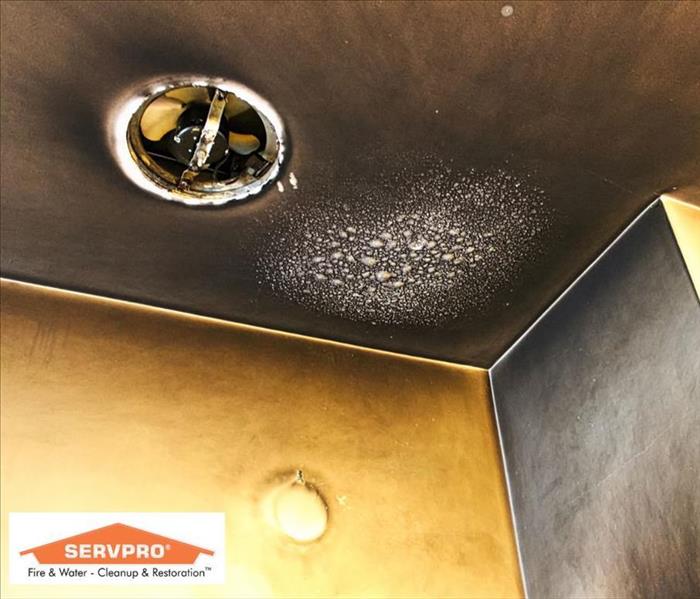 Smoke Damage
Smoke Damage
When we think of a fire's destructive force, we often envision flames engulfing everything in their path. However, there is a silent but equally menacing aspect of a fire's aftermath that often goes overlooked: smoke damage. Smoke can wreak havoc on a home and its contents, causing extensive and lasting harm. In this blog, we will delve into the perils of smoke damage and shed light on why enlisting SERVPRO Of Cedar City/Fillmore is the wisest choice when facing such a situation.
The Devastating Impact of Smoke Damage
Smoke damage is an insidious force that permeates every nook and cranny of a home. As a fire burns, it releases particles and harmful gases into the air. These tiny particles and toxic fumes can penetrate various surfaces, leaving a lingering stench and discoloration. Commonly affected areas include walls, ceilings, floors, furniture, electronics, and even HVAC systems. The longer the smoke residue remains untreated, the more it ingrains itself, making it increasingly difficult to remove without professional intervention.
1. Health Hazards
One of the most alarming consequences of smoke damage is the detrimental impact it can have on the health of occupants. Smoke particles can trigger respiratory issues, eye irritation, and worsen pre-existing conditions like asthma or allergies. Additionally, the harmful gases released during combustion can be life-threatening if inhaled for prolonged periods.
2. Structural Deterioration
Smoke residues contain corrosive substances that can damage building materials over time. Wooden structures may weaken, and metals can corrode, compromising the overall integrity of the property. Addressing smoke damage promptly can prevent further deterioration and save homeowners from costly repairs down the line.
3. Lingering Odors
Smoke odors are notorious for their tenacity. They can linger for months or even years if not treated properly. Attempting to mask the smell with air fresheners or DIY solutions only provides temporary relief and does not address the root cause. Professional restoration companies employ advanced techniques to neutralize odors at their source.
How a professional company like SERVPRO Of Cedar City/Fillmore is your best choice
In the face of such formidable challenges, entrusting the process to SERVPRO Of Cedar City is the most prudent decision homeowners can make. Here's how these experts can help:
1. Comprehensive Assessment
A reputable restoration company will begin by conducting a thorough assessment of the property and its contents. They'll identify the extent of the smoke damage and create a detailed plan to address each area effectively.
2. Specialized Equipment and Techniques
Professional restoration companies utilize specialized equipment and techniques that are beyond the reach of DIY methods. High-powered vacuums, ozone machines, air scrubbers, and thermal foggers are just a few examples of the advanced tools used to eliminate smoke particles and odors.
3. Safe and Efficient Cleaning
Smoke damage requires meticulous cleaning to prevent further harm. Trained technicians know which cleaning agents and methods are suitable for different surfaces and materials. They can salvage and restore items that might seem beyond repair to untrained eyes.
4. Preventive Measures
A reliable restoration company doesn't just treat the visible damage; they also implement preventive measures to mitigate future risks. This might include sealing surfaces to prevent smoke particles from resurfacing, or providing advice on fire-resistant materials for reconstruction.
Smoke damage can be just as devastating as the fire itself, leaving a trail of destruction that extends far beyond the immediate aftermath of a blaze. The health hazards, structural deterioration, and persistent odors associated with smoke damage underscore the need for professional intervention. By enlisting the services of SERVPRO Of Cedar City, homeowners can rest assured that their property and belongings will be restored to their original condition. The expertise, specialized equipment, and preventive measures offered by SERVPRO Of Cedar City make them the best choice in facing the daunting task of smoke damage restoration.
Fire Emergency Tips for Homeowners With Pets
6/23/2022 (Permalink)
 Follow our Fire Emergency Tips and protect your Pets, Family and Property.
Follow our Fire Emergency Tips and protect your Pets, Family and Property.
Your pets bring you incalculable joy and comfort, and their well-being is likely a high priority for your family. That's why they need to be part of any fire emergency plan you have for your home in Cedar City, UT.
Pet Safety Strategies To Use During a Fire
Any animal you have in your home depends on you for its safety and care. Pet preparation for a home fire boils down to rescue assistance, accident prevention and an emergency escape plan.
Make Pet Rescue as Easy as Possible
When you travel, you likely take your pets with you or leave them with a sitter. If they're home alone while you're out for the day, though, your pets still need a way to get out in the event of a fire. Most of the time, the task is going to fall to the firefighters who arrive on the scene.
Their main priorities, however, are going to be making sure that there are no people to rescue and putting the fire out so that it doesn't spread. There are a few precautions you can take ahead of time to make it easier to free your pets:
- Place a pet alert decal on a window near the front door of your home. This tells firefighters or anyone else who may need to enter that the animals are present.
- Keep pets near the front door when you leave your home for the day so that the emergency team doesn't have to look for them.
- Make sure your pets are wearing collars and that leashes are within grasp near the front door.
Prevent Animals From Starting Fires
The best way to handle a fire emergency is to keep it from happening altogether. Pets don't recognize fire hazards, so you need to take precautions on their behalf. Never leave a pet alone with an open flame. You may not think it's a big deal to leave the room with the fireplace still blazing or a lit candle sitting on the table, but it only takes a matter of seconds for a curious cat or dog to get too close and cause a problem.
Young pets are particularly prone to accidents. If you ever leave your young dog alone at home, for example, you need to puppy-proof any area it has access to. Remove the knobs from the stove so that the animal doesn't chew or brush against them and ignite the burners. Better yet, keep young pets crated or sequestered away from potential threats.
Include Pets in Evacuation Plans
Any fire escape plan you have for your family needs to include pet safety. Designate a specific member of the family to make sure the pets get out. Incorporate the animals in your family fire drills so that they are more likely to remain calm and listen to commands if an actual emergency occurs.
Certified restoration experts advise that you adequately prepare the whole family for a fire emergency. This includes any pets that live in your home. Understanding how to keep your beloved animals safe is a key component of pet ownership.
Common causes of home fires
6/10/2022 (Permalink)
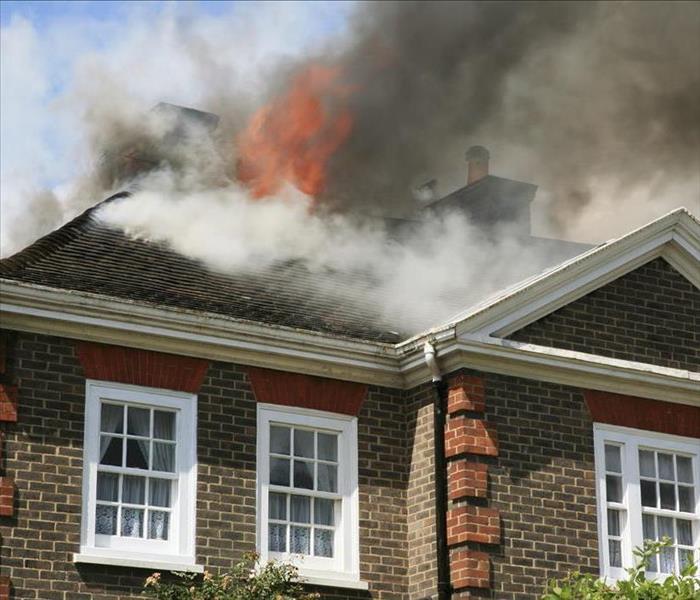 Fire on the rooftop of a home in Cedar City
Fire on the rooftop of a home in Cedar City
There are several ways that fires can start within your home. As important as house fire prevention is if we were to try to list all of the ways that a fire can start in a home the list would quickly become longer than most people would want to read or be able to remember well. With this in mind, we will cover a few different and more common causes of house fires in this post and more causes in additional posts as well.
Cooking: Overheating pots or pans, cooking with oil, using high temperatures, becoming distracted, and leaving the kitchen unattended are all contributing factors to fires that start while cooking.
Heating Systems: Ways to avoid your heating system becoming the source of a home fire start with proper maintenance such as an annual inspection of your furnace by a qualified technician, and having your chimney cleaned. It is also helpful to keep portable heaters at a safe distance from flammable material.
Smoking: The use of deep ashtrays can be helpful in avoiding a fire caused by smoking. Ensure that all cigarettes are extinguished before being tossed, keep ashtrays on non-flammable surfaces, and ensure that all cigarettes/embers that may have fallen are removed from any furniture.
As was mentioned this list of common house fire causes is not all-inclusive. While we always hope that you are not affected by a house fire we know that even when preventative measures are taken house fires still happen.
If you experience a house fire one of the best things that you can do is to call. We have extensive experience with the cleaning and remediation of fire-damaged homes. We also are well versed in working with insurance companies. Our goal is to make it "Like it never even happened."
Smoke Alarms: Life Savers
6/10/2022 (Permalink)
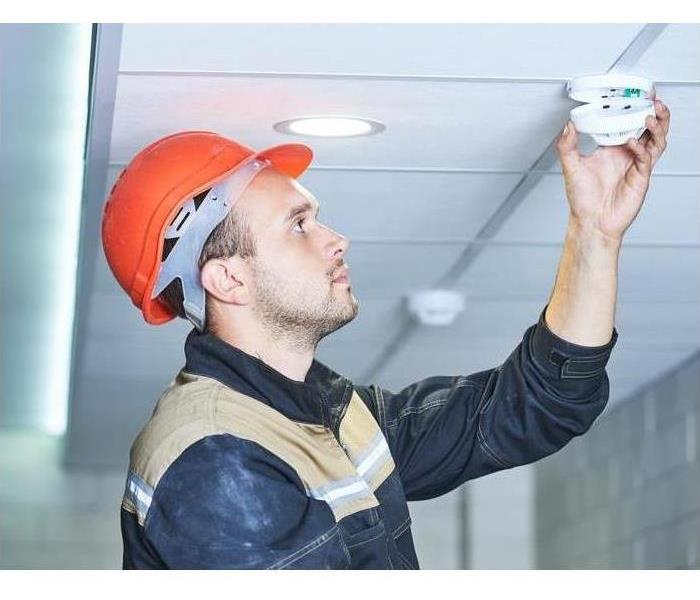 Smoke alarms installation can save lives.
Smoke alarms installation can save lives.
Smoke alarms save lives when properly installed and maintained, according to the National Fire Protection Association (NFPA).
In homes, smoke alarms should be in every bedroom and on every level including the basement. In-office and commercial environments, check your state requirements or contact your local Fire Marshal to help ensure all codes are met.
Test smoke alarms monthly by using the test button. Smoke alarms with non-replaceable batteries need the entire smoke alarm unit replaced every ten years. Other alarms need batteries replaced every year and the unit itself should be replaced every ten years.
If the alarm is sounding, it is signaling a low battery, take the proper steps to replace the unit or the batteries immediately. Do not ever disable or remove the battery from an alarm. Almost half of all fires where smoke alarms were present did not activate and had missing or disconnected batteries.
In larger commercial facilities, hardwired or wireless smoke alarms offer benefits such as not needing to be tested as often and activating throughout the entire building if smoke is detected in just one area.
if you require assistance installing, testing, or changing batteries in your smoke alarms, contact your local fire department, an electrician, or the American Red Cross.
Be sure your home or workplace has a fire emergency plan in place and conduct regular fire drills.
Carpet Cleaning after Fire Damage
6/10/2022 (Permalink)
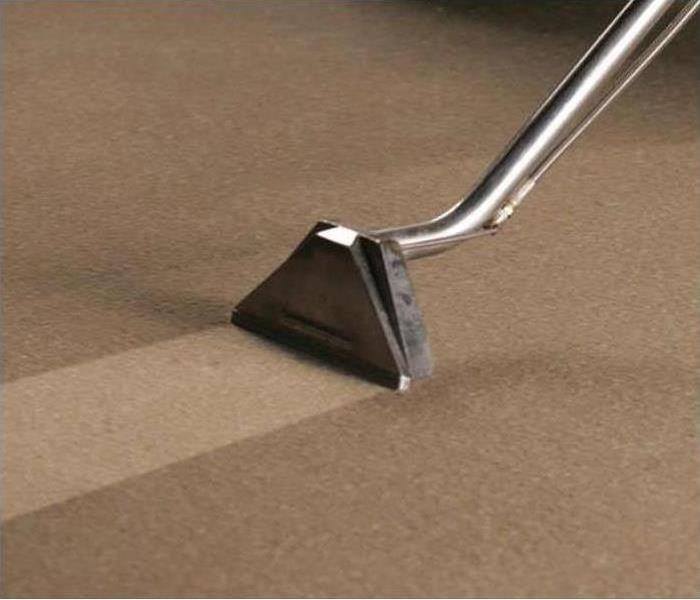 Carpet damage and soot after a house fire.
Carpet damage and soot after a house fire.
We have all been in that situation where you move the couch while cleaning the living room and, Boom! You see how dirty your carpet really is. The difference between under the couch and right in front is staggering. If you have a home fire it becomes even clearer that you will need a professional company to get your carpet looking good again. The question is from who?
Please allow me to tell you why SERVPRO Of Cedar City/ Fillmore is the best choice. Our professional crew can address moderate and heavy soil conditions in your carpets. Here are a few reasons why we are your number one choice:
- Truck-mounted extraction unit. The benefits of this include:
- Higher Cleaning Temperature- higher temperature will activate the washing agents more effectively and aid in killing all that bacteria.
- Greater Psi- With more pressure, the more dirt and soil will be removed from the carpet.
- Higher Vacuum Levels- Less water will be left in your carpet and therefore dry time will be a lot faster with an average of up to two hours
- Faster Cleaning Time- They are easier to set up and have less down time during a task allowing for cleaners to be more efficient with time.
- Training- All or technicians are trained. All technicians take a two-day course covering pre-inspection, fabric identification, cleaning chemicals and equipment, and proper cleaning techniques for residential and commercial applications
- Green Chemical- SERVPRO takes safety and transparency seriously, and will be providing the ingredients disclosure sheet and safety data sheet for each of our products. All products manufactured and distributed in the United States are subject to local, state and federal regulations for transparency, use and disposal.
- Customer Service- We know that you as a consumer are our life blood as a business. Because of that we strive to give each customer the best experience possible. We do this by having knowledgeable technicians, upfront pricing and timely service. We want to make your experience the very best.
We will get the job done right. For a cleaning backed by state-of-the-art equipment, over 40 years of experience, and Professionals trained to the highest standards, call us today.
How To Clean Items After a Fire
4/28/2022 (Permalink)
 Fire damage can be devastating for your business in Cedar City, UT.
Fire damage can be devastating for your business in Cedar City, UT.
The damage to your building in Cedar City, UT, maybe your primary concern after a fire, but damage to the items in your building can be just as extensive. Restoring everything in your building starts with a call to fire restoration experts. Whether you need dry-cleaning, ultrasonic treatment, or some other process, they know the method that works best for each item.
Items To Clean After a Fire
Documents
If your documents have been destroyed by the fire, there isn't much that can be done. If they only have smoke or water damage, however, technicians may be able to salvage them with the right content cleaning process:
- Air drying
- Freeze drying
- Thermal drying
- Dehumidifying
You don't want to leave papers damp as excess moisture can cause mold growth or other secondary damage. Proper restoration can save your important documents.
Textiles
Curtains and window treatments can make an office feel warmer and more inviting. After a fire, these items are the most likely to hold on to soot and smoke smells. Technicians use dry-cleaning to loosen and release the particles trapped in the fibers. This method also protects your textiles from unnecessary fading and water damage.
Electronics
When your computers, office equipment, or other machines have been in or near a fire, it's important to make sure they are fully restored before you try to use them again. Experts set each piece aside in content storage and inspect it to make sure it's salvageable. Then they clean it thoroughly so that there are no problems when you plug it back in.
Porous Surface
Any permeable item probably has smoke trapped inside it after a fire. A machine that emits ultrasonic pulses uses vibrations to release the particles and clean the item. This process can be used on items made of glass, plastic, or aluminum as well as certain small electronic items.
Dry-cleaning and other restoration technology can be used to clean items after a fire. Making sure both the building and everything inside it are smoke-free is necessary for full restoration.
3 Ways to Be Rid of Smoke Odors Fast
4/28/2022 (Permalink)
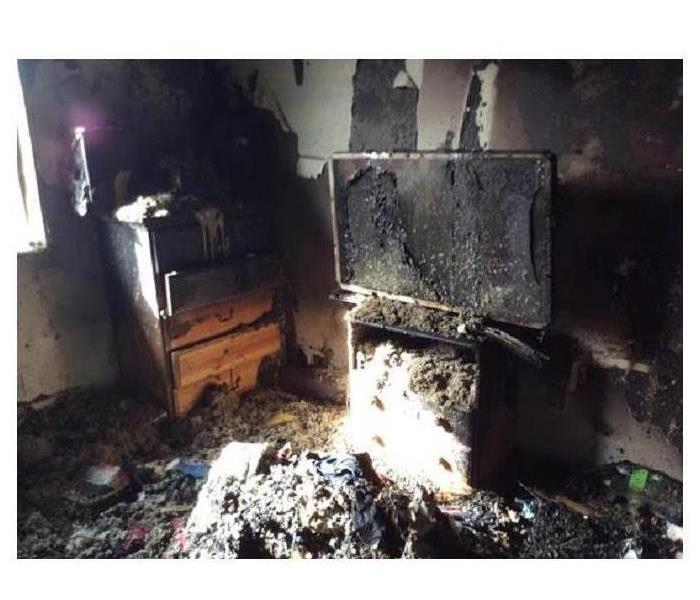 A devastating fire can be cleaned and repaired by our team of fire experts.
A devastating fire can be cleaned and repaired by our team of fire experts.
Whether the result of a fire or merely of a guest with a habit, smoke odors can be tough to get rid of. When the smoke has infiltrated your Cedar City, UT, home, smoke cleaning is in order. Do you know what to do? Start with these three tips and you’ll be rid of smoke odor fast.
3 Tips To Get Rid of Smoke Odors Fast
What Causes the Smell
Smoke can cause odors by direct contact with materials or via getting into a building’s HVAC system. Smoke can penetrate things like
• Furniture
• Walls
• Carpets
Smoke smells can be tough to get rid of, but there are a few steps that can help.
Remove the Source
Removing the source of smoke smells is one of the most obvious steps to take. Furniture in an area frequented by a smoker can hold odors and may be a loss. In the event of a fire, items that are extensively exposed in the room whether the fire started can be a big source of smell, so you’ll want to get rid of them as part of your smoke cleaning efforts.
Clean What You Can
Particularly after a fire, it’s tempting to toss out the obviously damaged items and move on. But even things that aren’t destroyed can be reservoirs for smoke damage. Use a wet sponge to wipe down porous surfaces and a dry one for less porous materials.
Use an Odor Counteractant
For the best results, you may want to invest in an ozone treatment. Ozone is what causes the fresh, clean scent we sense after rain. Ozone treatment works by exposing smoke damaged surfaces to ozone gas for a set amount of time. This is typically highly effective.
Air quality can have a huge impact on your quality of life. If smoke odors persist in your home, try the above tips or reach out to an expert in ozone smoke cleaning to get the stink out.
Additional Common Causes of House Fires
4/28/2022 (Permalink)
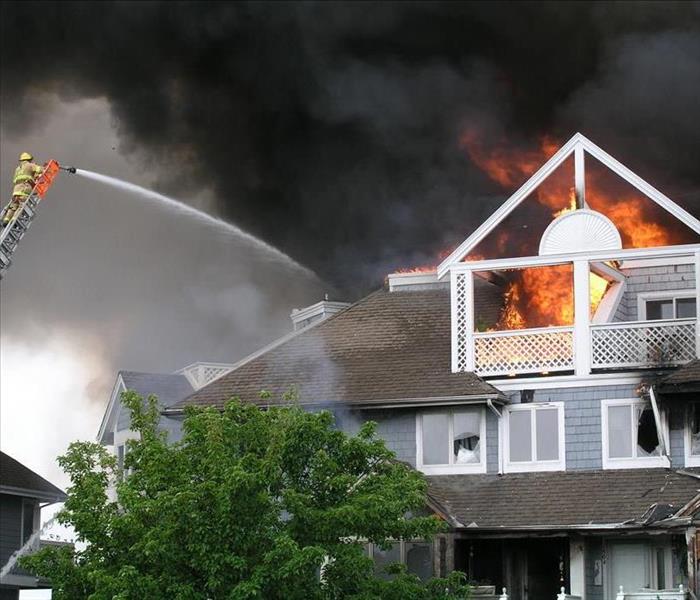 Fires can be caused by candles, electrical, and children.
Fires can be caused by candles, electrical, and children.
There are several ways that fires can start in a home. As important as house fire prevention is if we were to try to list all of the ways that a fire can start in a home the list would quickly become longer than most people would want to read or be able to remember. With this in mind, we will cover a few different and more common causes of house fires in this post and more causes in additional posts as well.
Common Causes of Home Fires
Electrical Equipment:
- Ensure that cords and plugs don’t have loose or frayed ends, and outlets are not overloaded with plugs. Avoiding the overuse of extension cords is all important thing to be aware of as they can cause house fires. Another aspect of electrical equipment that is important to be aware of is the quality of the electrical wiring in the house. If the quality of the electrical wiring in the house is not sufficient for the electrical needs of the people in the home the wiring can overheat and start a fire.
Candles:
- Candles can be a cause of a house fire starting. It is important to only use candles in places where they are not close to combustible materials. Candles should not be left burning when no one is in the room with them. It is also important to make sure that candles are placed on a surface where they are not likely to tip over or be tipped over.
Children Playing With Fire:
- As wonderful as children are they are also full of wonder. One of the things that is a large source of wonder for children is fire. Curious children often have an interest in fire and sometimes they will not make the best choices when it comes to satisfying their curiosity or wonder about the fire. Matches and other devices used to start fires should always be stored in places that are not easily accessible to children. Parents should also take time to educate their children about fire and the dangers associated with its use.
While we always hope that you are not affected by a house fire we know that even when preventative measures are taken house fires still happen. We have extensive experience with the cleaning and remediation of fire damaged homes. We also are well versed in working with insurance companies. Our goal is to make it "Like it never even happened."
4 Essentials to Know About Fire Extinguishers
3/11/2021 (Permalink)
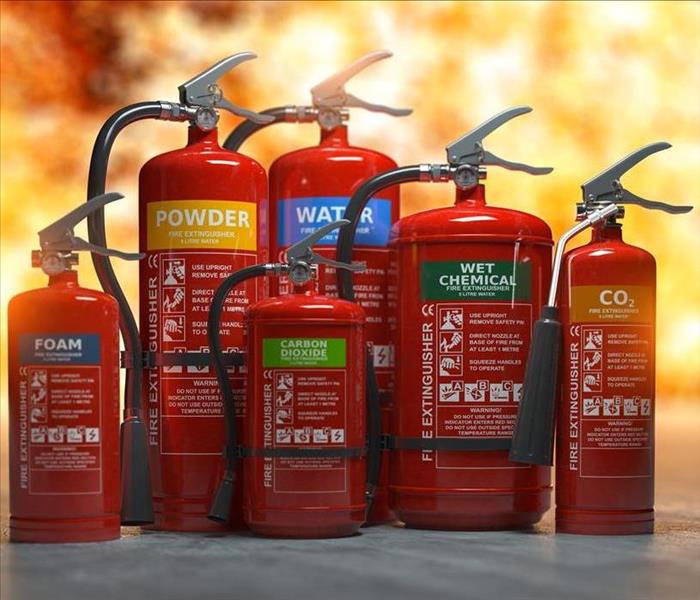 Fire extinguishers
Fire extinguishers
Fire safety is essential for both commercial and residential properties. It’s important to have safety measures in place for both types of properties, and a great place to start is having the right fire extinguisher at the ready, especially if you’re worried about fire damage remediation.
The first step to properly using a fire extinguisher is to understand it. Let’s begin by going over the different classes and types of fire extinguishers, then discuss when and when not to use them.
Fire Extinguisher Classes
There are five types of fire extinguisher classes. Each class represents the type of fire the extinguisher is capable of putting out. If you have a fire extinguisher, you need to know which classes your fire extinguisher can put out, especially if you want to avoid fire damage.
- Class A: Class A means a fire was started with typical combustible materials. These types of materials include wood, paper, and cloth.
- Class B: Fires in Class B are started with combustible or flammable liquids. These liquids include paints and gasoline.
- Class C: When energized electrical equipment is the source of a fire, it is categorized as a Class C fire. Short circuits in power transmission cables are common sources for this type of fire.
- Class D: When metals start a fire, the fire is considered Class D. Metals such as lithium, sodium, and potassium are common Class D fire sources.
- Class K: The last class of fires, Class K, means any fire that was started in a kitchen.
Types of Fire Extinguishers
Just like there are different classes of fires, there are different types of fire extinguishers. Many residential and commercial properties use a basic fire extinguisher, which is often sufficient for the environment. But sometimes a more specialized extinguisher is required for places like laboratories or warehouses.
Water and Foam
Water and foam fire extinguishers use water to eliminate the heat of a fire and the foam to remove any oxygen. This is a basic fire extinguisher and should only be used for Class A fires.
Carbon Dioxide
A carbon dioxide fire extinguisher replaces the oxygen in a fire with carbon dioxide. When the gas is released from the pressurized container, it releases cold, which helps to decrease the heat of the fire. These types of fire extinguishers should only be used for Class B and C fires.
Dry Chemical
Dry chemical fire extinguishers target the chemical reaction of a fire. This is the most common type of extinguisher and can be used on Class A, B, and C fires if it is a multi-purpose dry chemical extinguisher. If it is an ordinary dry chemical extinguisher, it can be used only on Class B and C fires.
Wet Chemical
Wet chemical extinguishers not only remove the heat of a fire but put up a barrier between the oxygen in the fire and the fuel. This prevents the fire from re-igniting. Wet chemical fire extinguishers should only be used for Class K fires, such as those started with oils.
Clean Agent
This type of fire extinguisher uses halon agents to extinguish a fire. By using halocarbon agents, it can interrupt the chemical reaction taking place in a fire. Clean agent extinguishers can be used on Class B and C fires.
Dry Powder
The dry powder in this extinguisher acts as an agent to separate oxygen from a fire’s fuel. While this type is similar to dry chemical extinguishers, it should only be used for Class D fires.
Water Mist
This simple extinguisher targets the heat of a fire to eliminate it. Water mist extinguishers work on Class A and C fires.
Cartridge-Operated Dry Chemical
This is another fire extinguisher that interrupts the chemical reaction taking place in a fire, which in turn creates a barrier between the fuel and the oxygen. It can be used on Class A, B, and C fires.
When to Use Fire Extinguishers
It may seem obvious to use a fire extinguisher in the event of a fire, but before using one, you should take a few fire safety precautions to keep everyone in the building safe.
Check to Make Sure the Fire is Contained
You don’t want to use a fire extinguisher on an uncontained fire. This can put you and those around you at risk.
Do Not Use an Extinguisher If the Room is Filled with Smoke
If the fire is contained, the next step is to check for smoke. If the room is filled with smoke, don’t pull out the extinguisher.
Evacuate the Building
During any fire, the number one concern should be for those in the building. Before putting out the fire with an extinguisher, make sure everyone has evacuated the building.
Once you have made sure the fire is contained, the room isn’t filled with smoke, and everyone has been evacuated, you can use the proper fire extinguisher to put on the fire in the building. Be sure to alert the fire department as well.
How to Use Fire Extinguishers
While using a fire extinguisher isn’t hard to do, you should know how to use one in case of a fire. To put out a fire with an extinguisher, there are four basic steps you need to follow.
1. Pull the Pin on the Fire Extinguisher
By pulling this, the lock on the extinguisher will be released. You will then be able to spray the fire extinguishing agent.
2. Aim the Fire Extinguisher at the Base
Aim for the base of the fire. This will help you prevent the fire from blowing and spreading around the building.
3. Squeeze the Lever on the Fire Extinguisher
Once you aim at the base of the fire, squeeze the lever to release an extinguishing agent.
4. Move the Fire Extinguisher Nozzle Side to Side
As you’re squeezing the lever, sweep the nozzle from side to side until you have the fire doused. Continue this until the fire is out.
Contact SERVPRO
If you need help determining which fire extinguisher is right for your residential or commercial property, feel free to reach out to SERVPRO of Cedar City Fillmore. We can also help you with fire damage remediation and fire restoration. Contact us for fire restoration services today.
Out of the Ashes? What Can and Cannot Be Saved After a Fire
2/18/2021 (Permalink)
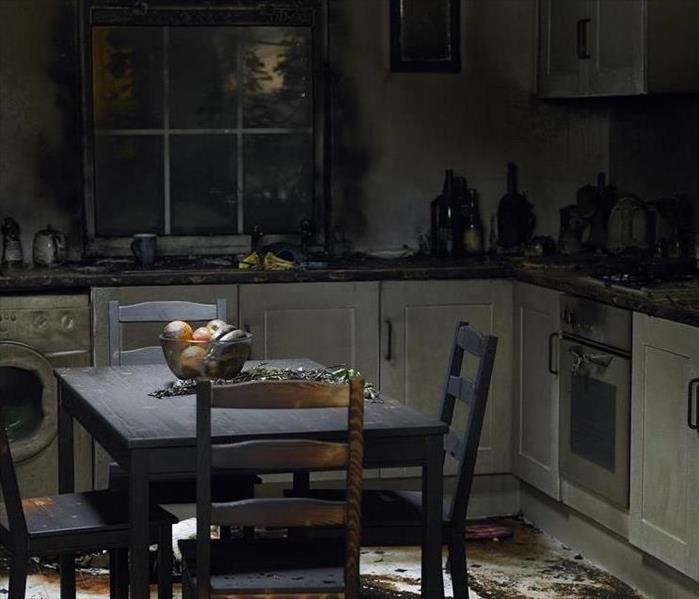 Fire in Kitchen
Fire in Kitchen
A house fire is a horrific event. Even if everyone in the home makes it out safely, the physical damage on the structure will be intense. That pain will only be matched by the acute mental and emotional anguish endured by those living there.
There are many factors that will determine what, if anything, can be saved once the flames are extinguished. Our technicians at SERVPRO of Cedar City/Fillmore are often surprised by what survives even the most intense fires. Books, wood furniture, tools, certain types of pottery and stoneware might have a life after the blaze. Even pictures and important family documents have been found fully intact under piles of ash and debris.
How does fire damage things and what needs to be thrown out?
Visible fire damage is not hard to spot. What will not be as evident is what has been impacted by extreme heat and flames. Even if there is no apparent physical damage, get rid of certain materials, including:
- Insulation
- All food that was in the house (both perishable and non-perishable)
- Cosmetics
- Medication
- Cleaning supplies
While these kinds of items might have avoided visible fire damage, they may have come in contact with toxic chemicals. Combustion, the process of something burning, releases harmful chemicals like hydrogen cyanide, sulfur dioxide, and tar. That is nasty stuff.
You cannot eat food that has been exposed to heat or the chemicals produced during combustion. Medication, cosmetics, and most cleaning supplies also react negatively with heat and must be discarded. Burned insulation no longer insulates, and it is impossible to clean the accumulated soot and smoke odor. However, our SERVPRO technicians remove the top three to four inches of insulation in case the problem only involves residue deposits.
How we can help?
Fire affects ALL materials at the site. Meticulous and detailed scoping is necessary before deciding what to throw and what, if anything, can be kept. Our SERVPRO technicians consider three main factors:
- Can it be restored?
- How much will it cost?
- What is the sentimental or monetary value of the item?
After a thorough inspection of your property, our technicians can assess when items can be restored. Restoration, not replacement, is always what we strive for initially in an effort to save your beloningings and to save you money.
Contact us today! We're faster to any size disaster to minimize damage. SERVPRO of Cedar City/Fillmore helps in addressing various challenges sparked by fire damage, including making tough decisions on the fate of valuables. Call us at (435) 251-9241.
6 Things to Consider When Creating a Fire Escape Plan
2/5/2021 (Permalink)
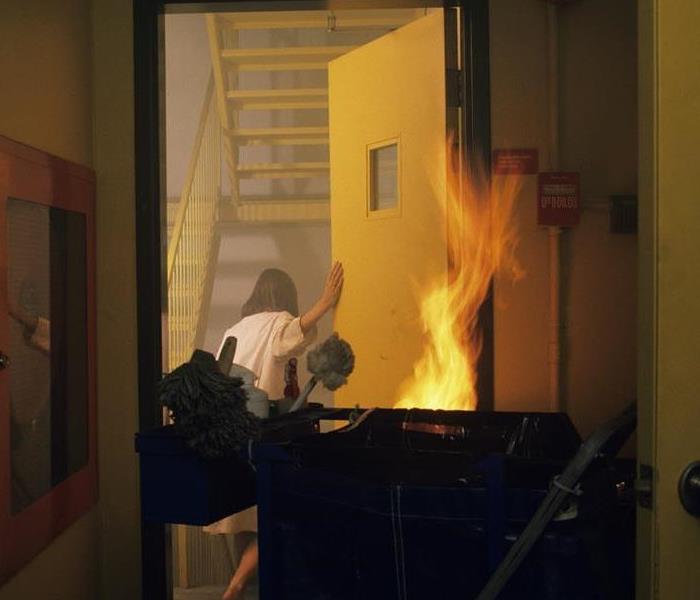 Escaping a fire. Having a plan
Escaping a fire. Having a plan
Home fires are scary and spread extremely quickly, so every second counts. Protect your home and family by developing a fire escape plan, and prepare yourself for how to respond in an emergency. For more information on how to prepare yourself and your family for disasters, visit ready.gov.
1. Ensure Reliable Alerts
Having working smoke detectors in your home is one of the most important things you can do to practice fire safety for you and your family. You should place at least one on every floor of your home, including the basement, and one in each bedroom. Keep the devices working by replacing batteries twice per year and testing them monthly. Never disable your smoke alarm for cooking.
Ensure that members of your household each recognize the sound of the alarm and understand what it means. For individuals who may be hearing or visually impaired, consider getting a smoke detector with a vibrating pad or strobe lights.
2. Map Out an Escape Route
Next, map out the escape routes from each area inside your home. It’s a good idea to identify two ways to get out of each room, in case one exit is compromised by flames, heat, or structural failure. Make sure that the windows in your home aren’t jammed and that screens can be easily removed.
3. Involve the Kids
If you have children, it’s important to involve them in your fire escape plan. Home fires are scary experiences, so you should teach them the importance of not hiding from firefighters, as well as common fire wisdom like crawling along the floor in smoke-filled rooms and “stop, drop, and roll” in case of clothing catching fire. Make sure they understand your plan and can take the escape route on their own.
1. Practice Your Plan
Once you have your fire escape plan set, practice it together twice per year to keep everyone’s memories fresh and to avoid confusion. Consider practicing feeling your way to the outside of your home with your eyes closed.
2. Safeguard Important Documents
Part of the devastation of home fires is dealing with the aftermath and all the personal possessions that are lost. Make digital copies of important documents like birth certificates, marriage licenses, and property deeds and store them safely online or on a fireproof hard drive. You may want to back up family photos as well.
3. Keep a Fire Extinguisher
Attain a fire extinguisher and keep it in your home in case of an emergency. Most likely, you’ll want to put it in the kitchen, since cooking fires are more frequent than fires in other parts of the home. Learn how to use it.
Cleanup and Restoration in Southern Utah
SERVPRO of Cedar City/Fillmore is your local source for reliable disaster cleanup services. Our trained technicians are available 24/7 to respond quickly to emergencies and are highly skilled at handling damage from water, fire, mold, and other sources. We live in this community, too, and are proud of our reputation for providing honest and effective services at fair prices. Contact us today to learn more.
6 Ways to Keep Your Clothes Dryer from Causing a Home Fire
2/5/2021 (Permalink)
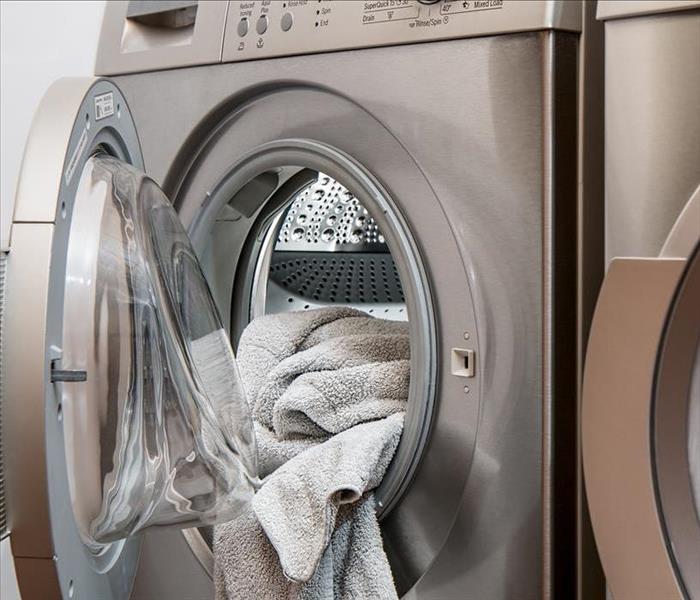 Dryer Fire
Dryer Fire
According to the National Fire Protection Association, clothes dryers are the cause of more than 13,000 home fires each year in the United States, causing more than $200 million in damages. No one wants to experience a home fire, and luckily there are several steps you can take to reduce the risk of your clothes dryer causing flames. Follow these six steps to keep your home safe from dryer fires.
1. Clean the Lint Filter
Cleaning the lint filter is the most important piece of dryer maintenance to remember. The interior of a dryer can reach more than 500 degrees Fahrenheit during use, and if too much lint has accumulated on the filter, it can easily spark and ignite. After every use, remove the lint filter from your dryer and run your hand over it to remove lint buildup. Rinse the trap under a faucet and replace it in the dryer once it’s fully dried. It’s also good to wipe down the interior of the machine periodically, and remember: never use the dryer when the lint screen is missing.
Not only will cleaning the lint filter protect you, but it can save your wallet too. A blocked lint filter causes your dryer to use more energy, so keeping it free of debris will save you money on utility bills.
2. Don’t Overload
We’ve all experienced getting behind on laundry and having to catch up all in one day. However, it’s important to resist the temptation to overload your dryer, especially if you’re drying thick items like towels or blankets. Overfilling the drum can cause dryer components to work harder than they’re designed to and reach temperatures that are higher than safe, eventually causing a spark. It may seem inconvenient, but the longer time of splitting a large load into two is worth it.
3. Get Regular Inspections
Consider scheduling an annual visit from a qualified maintenance technician. He or she can clean the interior of your dryer and inspect it for mechanical and electrical failures. The venting and exhaust systems and gas line fittings could all benefit from a professional eye, and you’ll have peace of mind knowing that preventative maintenance can identify issues before they become major problems
4. Clean the Dryer Duct
The ventilation duct of your dryer carries excess hot air to the outside of your home, but lint can get caught there, too. These vents should be cleaned at least annually, and more if you have more than a few people living in your home. To clean out the dryer duct, move your dryer away from the wall and detach the large vent, then use a shop-vac or powerful vacuum with a hose to remove any lint that may have settled inside.
5. Don’t Dry Hazardous Chemicals
It’s also important not to dry anything that’s not meant to be put in the dryer. If your clothes have any sort of oil, gas, cleaning products, alcohol, or other flammable substances, wash them with soap and then hang them to dry. Look at the washing instructions on product labels and don’t dry materials like plastic, foam, and rubber.
6. Only Run Laundry When You’re Nearby
It’s tempting to put a load of laundry in the dryer before dashing out the door to run an errand, but you should only run your clothes dryer when you’re at home and awake. This way, in case a fire does start in your dryer, you’ll have time to take action before it can grow and spread.
SERVPRO of Cedar City/Fillmore
SERVPRO of Cedar City/Fillmore is a professional cleanup and restoration company that specializes in providing quality services to our Southern Utah community. We are on call 24/7 to respond to emergencies like dryer fires and are highly experienced in dealing with damage from fire, water, mold, and more. For more information, contact us today.
How To Test Your Smoke Alarms
3/30/2020 (Permalink)
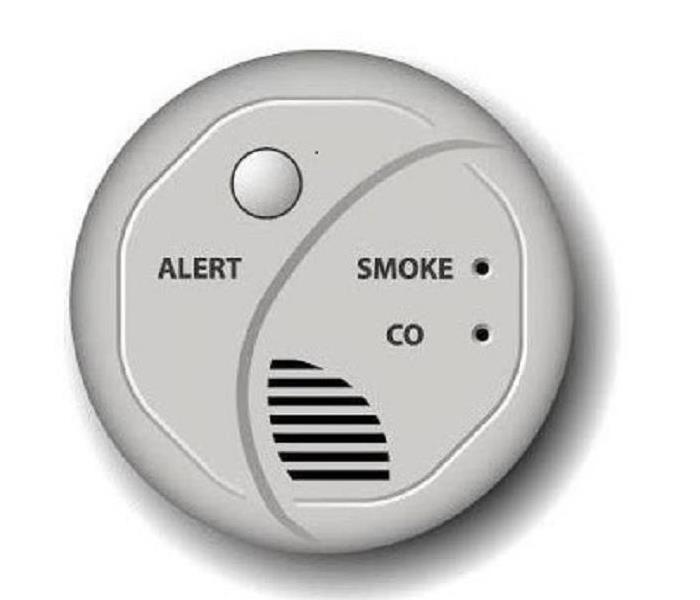 A smoke detector is important for fire safety.
A smoke detector is important for fire safety.
Fire safety should be at the top of every homeowner's list of concerns. While you hope that you never have to deal with fire damage in your home, having a reliable smoke alarm system in place is essential to protecting your family just in case a fire occurs. There are several things you need to do to make sure your fire alarm system staying in good working order.
Check the Age
A smoke detector can last a long time, but like everything else in your home, it eventually wears out and needs to be replaced. The process for checking the age of your detectors is simple:
Remove the detector.
Look on the back for the date it was manufactured.
Return the detector to the wall or ceiling if it's less than 10 years old.
If the date of your detector is over 10 years ago, you need to replace it. Your smoke alarm system is only as strong as its weakest detector, so check the dates at least once a year to make sure they're all still current.
Check the Alert
Even if your smoke detectors are all relatively new, they can still malfunction. Fire damage experts recommend that you check them every month to make sure they are still working. Push the button on the front of the detector. It should emit an alert. If it does not, you need to replace either the battery or the detector itself.
Check the Battery
The battery in every smoke detector in your home should be replaced at least once a year. Your monthly test may reveal that the battery is weak before the year is up, though. If the alert doesn't sound when you push the button, a new battery may solve the problem.
Your smoke alarm system is your first line of defense against being trapped in a burning home. Test your alarms on a regular basis, and replace them when necessary.
Cedar City Smoke and Soot Cleanup
2/12/2020 (Permalink)
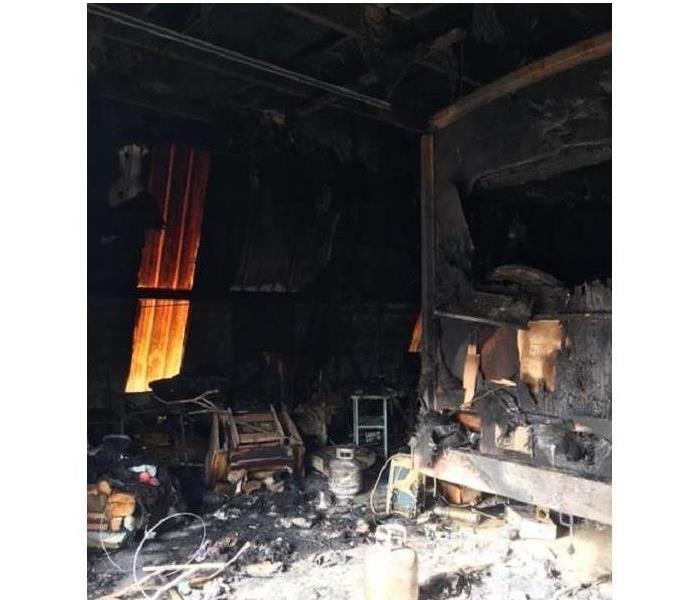 Severe fire damage in Cedar City, UT.
Severe fire damage in Cedar City, UT.
Smoke and soot is very invasive and can penetrate various cavities within your home, causing hidden damage and odor. Our smoke damage expertise and experience allows us to inspect and accurately assess the extent of the damage to develop a comprehensive plan of action.
Smoke and soot facts:
- Hot smoke migrates to cooler areas and upper levels of a structure.
- Smoke flows around plumbing systems, seeping through the holes used by pipes to go from floor to floor.
- The type of smoke may greatly affect the restoration process.
Different Types of Smoke
There are two different types of smoke–wet and dry. As a result, there are different types of soot residue after a fire. Before restoration begins, SERVPRO of Cedar City/Fillmore will test the soot to determine which type of smoke damage occurred. The cleaning procedures will then be based on the information identified during pretesting. Here is some additional information:
Wet Smoke – Plastic and Rubber
- Low heat, smoldering, pungent odor, sticky, smeary. Smoke webs are more difficult to clean.
Dry Smoke – Paper and Wood
- Fast burning, high temperatures, heat rises therefore smoke rises.
Protein Fire Residue – Produced by evaporation of material rather than from a fire
- Virtually invisible, discolors paints and varnishes, extreme pungent odor.
Our Fire Damage Restoration Services
Since each smoke and fire damage situation is a little different, each one requires a unique solution tailored for the specific conditions. We have the equipment, expertise, and experience to restore your fire and smoke damage. We will also treat your family with empathy and respect and your property with care.
Cooking Fire Danger
9/17/2019 (Permalink)
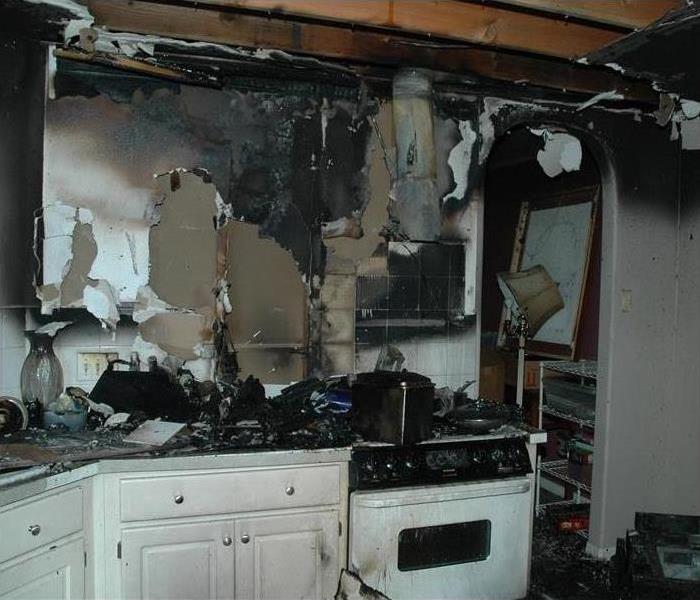 Unattended fire damage in a kitchen in Cedar City
Unattended fire damage in a kitchen in Cedar City
The holidays are such a wonderful time of the year to spend with your family and cooking is a big part of that time spent together.
It is important to be safe while cooking so here are some safety tips.
- Stay in the kitchen while you are frying, grilling, boiling, or broiling food.
- If you are simmering, baking, or roasting food, check it regularly, remain in the kitchen while food is cooking.
- Keep anything that can catch fire— oven mitts, wooden utensils, food packaging, towels or curtains—away from the stove top.
- Be on alert! If you are sleepy or have consumed alcohol don’t use the stove or stove top.
- Smart phones and other distractions can lead to cooking fires.
If you have a cooking fire, consider the following safety protocols to help keep you and your family safe.
- Just get out! When you leave, close the door behind you to help contain the fire.
- Call 9-1-1 or the local emergency number after you leave.
- For an oven fire turn off the heat and keep the door closed.
- If you try to fight the fire, be sure others are getting out and you have a clear way out.
- Keep a lid nearby when you’re cooking to smother small grease fires. Smother the fire by sliding the lid over the pan and turn off the stove top. Leave the pan covered until it is completely cooled.
Tips to stay safe while Having a Campfire
6/21/2019 (Permalink)
The weather is starting to warm up and with chilly nights you may way to add some of that warmth to your night. If you decide to have a nightly fire to enjoy those cool temps, here are some tips to help keep your house and your family safe.
- Keep fires at least 25 feet away from any structure and anything that could potentially go up in flames.
- Always clear away any dry leaves, low hanging branches,shrubs and any debris which can go up in flames.
- Avoid starting fires on windy nights/days. It is much easier for fires to spread in the wind.
- Always keep a close eye on pets and Small children and animals near campfires to prevent potential harm to your children and your pets..
- Never use gasoline or other combustible liquids to start or boost a fire up.
- Always keep a bucket of water, shovel or a up to date fire extinguisher to quickly put out a fire if it tends to get out of hand.
- Always make sure the fire is completely out before you leave the fire site.
- Next, Always make sure someone is watching the fire and it is never left unattended always put it out if your leaving it is not for long
Staying safe while cooking
6/21/2019 (Permalink)
The leading cause of fires in the kitchen is being left unattended and most of these incidents involve the stove. Here are some tips to help remove the chance of a kitchen accident.
- Create a kid-free zone of at least 3 feet area around the stove and where hot foods or drinks are made.
- Always be alert. Never use the stove or stove top if you are tired or have consumed any drugs or alcohol.
- When using the stove always stay in the kitchen. If you need to leave for any circumstance or amount of time always turn off the stove.
- Always keep anything that could catch fire away from the stove top. Including, oven mitts, food packaging, towels or curtains, Loose clothing articles.
- If you do have a small grease fire you can always smother it by putting a lid over the pan and never ever use water to put it out.
If you ever have doubt about a fire in your home always call 9-1-1.
 Ensure the safety of your household and loved ones. Reach out to SERVPRO of Cedar City/Fillmore today.
Ensure the safety of your household and loved ones. Reach out to SERVPRO of Cedar City/Fillmore today.



 24/7 Emergency Service
24/7 Emergency Service














